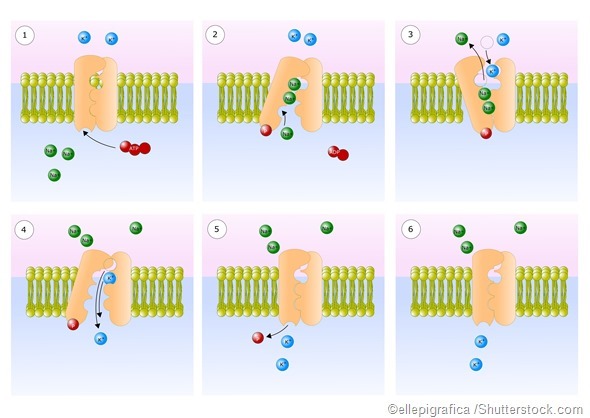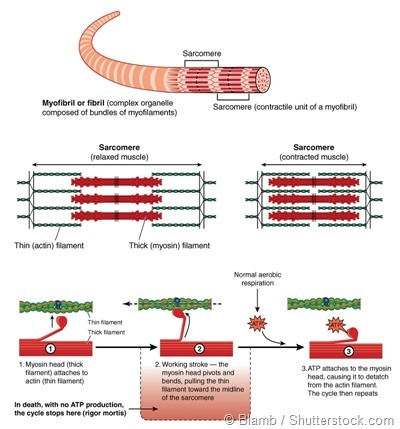How Do Cells Use Atp
Adenosine Triphosphate (ATP) Function in Cells
ATP is the main source of free energy for most cellular processes. The building blocks of ATP are carbon, nitrogen, hydrogen, oxygen, and phosphorus. Because of the presence of unstable, loftier-free energy bonds in ATP, information technology is readily hydrolyzed in reactions to release a big corporeality of energy.
The enzymatic removal of a phosphate group from ATP to form ADP releases a huge amount of energy which is used past the cell in several metabolic processes likewise as in the synthesis of macromolecules such as proteins. The removal of a 2nd phosphate group from ATP results in further free energy release and the formation of adenosine monophosphate (AMP).
When energy is not needed past the organism, the phosphate group is added dorsum to AMP and ADP to course ATP - this can be hydrolyzed later equally per required. Thus, ATP functions as a reliable energy source for cellular pathways.
Functions of ATP in cells
ATP finds use in several cellular processes. Some important functions of ATP in the cell are briefly discussed below:
Active Transport
ATP plays a critical part in the ship of macromolecules such as proteins and lipids into and out of the cell. The hydrolysis of ATP provides the required free energy for active transport mechanisms to carry such molecules across a concentration gradient. Transport of molecules into the jail cell is called endocytosis whilst transport out of the prison cell is known as exocytosis.

Prison cell Signaling
ATP has key functions both in intracellular and extracellular signaling. It is easily recognized by purinergic receptors in mammalian tissues - its release from synapses and axons activates purinergic receptors that modulate calcium and cyclic AMP levels inside the prison cell.
In the central nervous system, adenosine modulates neural evolution, the command of immune systems, and of neuron/glial signaling.
ATP is also involved in betoken transduction - its phosphate groups are used up by kinases in phosphate transfer reactions which activate a cascade of protein kinase reactions.
Structural Maintenance
ATP plays a very important role in preserving the structure of the cell by helping the assembly of the cytoskeletal elements. It also supplies free energy to the flagella and chromosomes to maintain their advisable functioning.
Muscle contraction
ATP is disquisitional for the wrinkle of muscles; information technology binds to myosin to provide energy and facilitate its binding to actin to class a cantankerous-bridge. ADP and phosphate are then released and a new ATP molecule binds to myosin. This breaks the cross-bridge between myosin and actin filaments, thereby releasing myosin for the next contraction.

Synthesis of Dna and RNA
During Dna synthesis, ribonucleotide reductase (RNR) reduces the saccharide balance from ribonucleoside diphosphates to form deoxyribonucleoside diphosphates such equally dADP.
Thus, RNR regulation helps proceed the residual of deoxynucleotides (dNTPs) in the jail cell. Depression concentrations of dNTPs inhibit DNA synthesis and repair whilst high levels are shown to exist mutagenic considering Dna polymerase tends to add the wrong dNTP during DNA synthesis.
The adenosine from ATP is a edifice cake of RNA and is directly added to RNA molecules during RNA synthesis past RNA polymerases. The removal of pyrophosphate provides the free energy required for this reaction.
Summary
ATP is an intricate molecule that serves as an free energy package for thousands of reactions that take identify in the cells of most organisms. Apart from humans, microorganisms also rely on ATP for their free energy needs.
ATP is a highly efficient molecular machine with a rapid turnover of energy that makes information technology suitable to meet the changing energy demands of the trunk. An ATP molecule is over 500 atomic mass units (AMUs).
Even as evolutionists wonder about life before the complex ATP molecule and alternatives to ATP, no other energy source currently exists that can accurately respond to the energy needs of the cell and carry out its crucial processes.
References
- http://www.ncbi.nlm.nih.gov/pmc/articles/PMC2877495/
- http://hyperphysics.phy-astr.gsu.edu/hbase/biology/actran.html
- www.chm.bris.ac.u.k./motm/atp/atp1.htm
- http://world wide web.trueorigin.org/atp.php
Further Reading
- All Jail cell Content
- Construction and Function of the Jail cell Nucleus
- What Are Organelles?
- Cilia and Flagella in Eukaryotes
- Mitosis vs Meiosis
Last Updated: Dec 5, 2019
Citations
Please use 1 of the following formats to cite this article in your essay, newspaper or report:
-
APA
Cheriyedath, Susha. (2019, Dec 05). Adenosine Triphosphate (ATP) Part in Cells. News-Medical. Retrieved on May 01, 2022 from https://www.news-medical.cyberspace/life-sciences/Adenosine-Triphosphate-(ATP)-Function-in-Cells.aspx.
-
MLA
Cheriyedath, Susha. "Adenosine Triphosphate (ATP) Function in Cells". News-Medical. 01 May 2022. <https://www.news-medical.internet/life-sciences/Adenosine-Triphosphate-(ATP)-Function-in-Cells.aspx>.
-
Chicago
Cheriyedath, Susha. "Adenosine Triphosphate (ATP) Function in Cells". News-Medical. https://www.news-medical.net/life-sciences/Adenosine-Triphosphate-(ATP)-Function-in-Cells.aspx. (accessed May 01, 2022).
-
Harvard
Cheriyedath, Susha. 2019. Adenosine Triphosphate (ATP) Function in Cells. News-Medical, viewed 01 May 2022, https://world wide web.news-medical.internet/life-sciences/Adenosine-Triphosphate-(ATP)-Part-in-Cells.aspx.
Suggested Reading








How Do Cells Use Atp,
Source: https://www.news-medical.net/life-sciences/Adenosine-Triphosphate-(ATP)-Function-in-Cells.aspx
Posted by: smileytheighty.blogspot.com



0 Response to "How Do Cells Use Atp"
Post a Comment